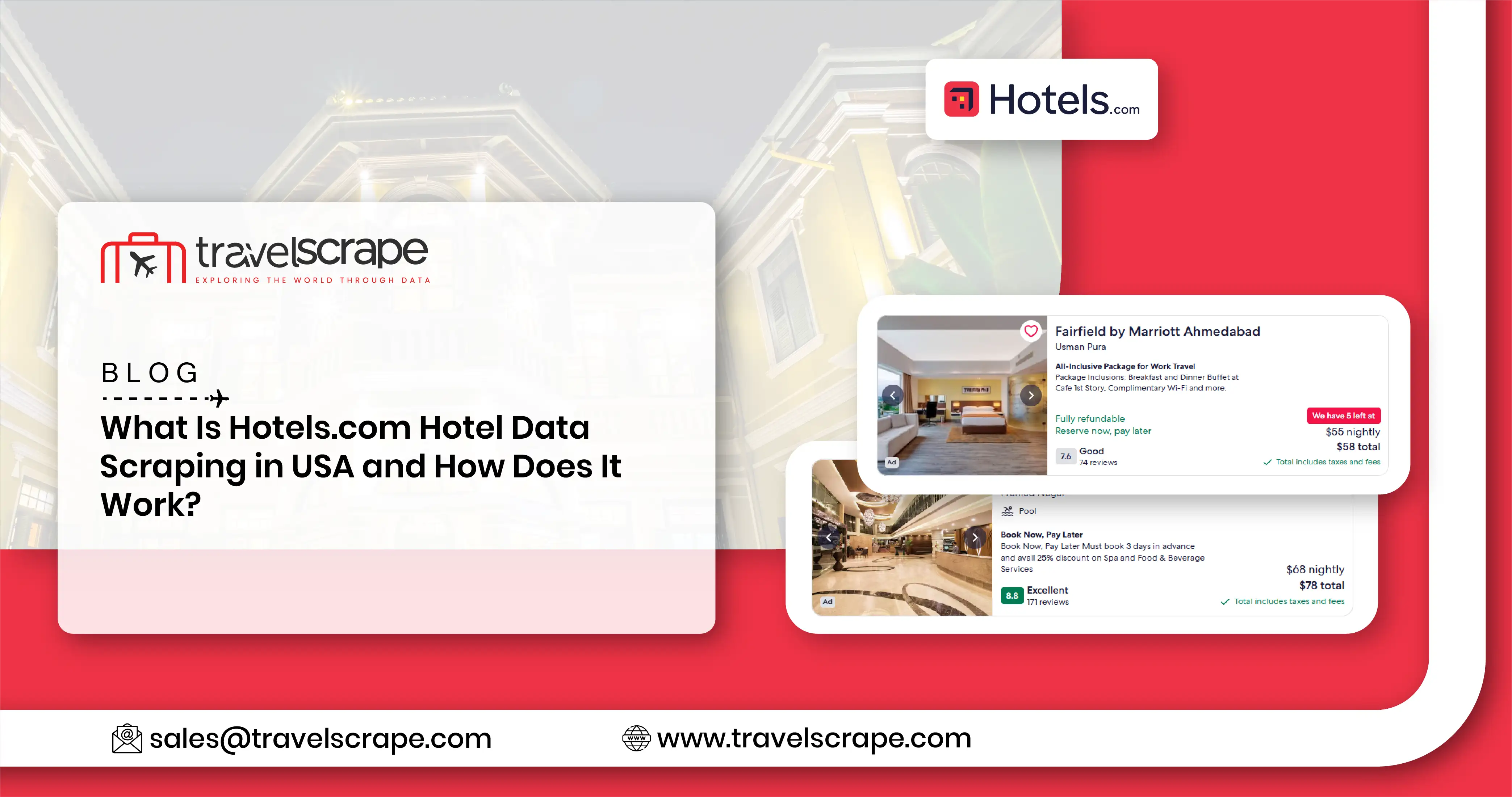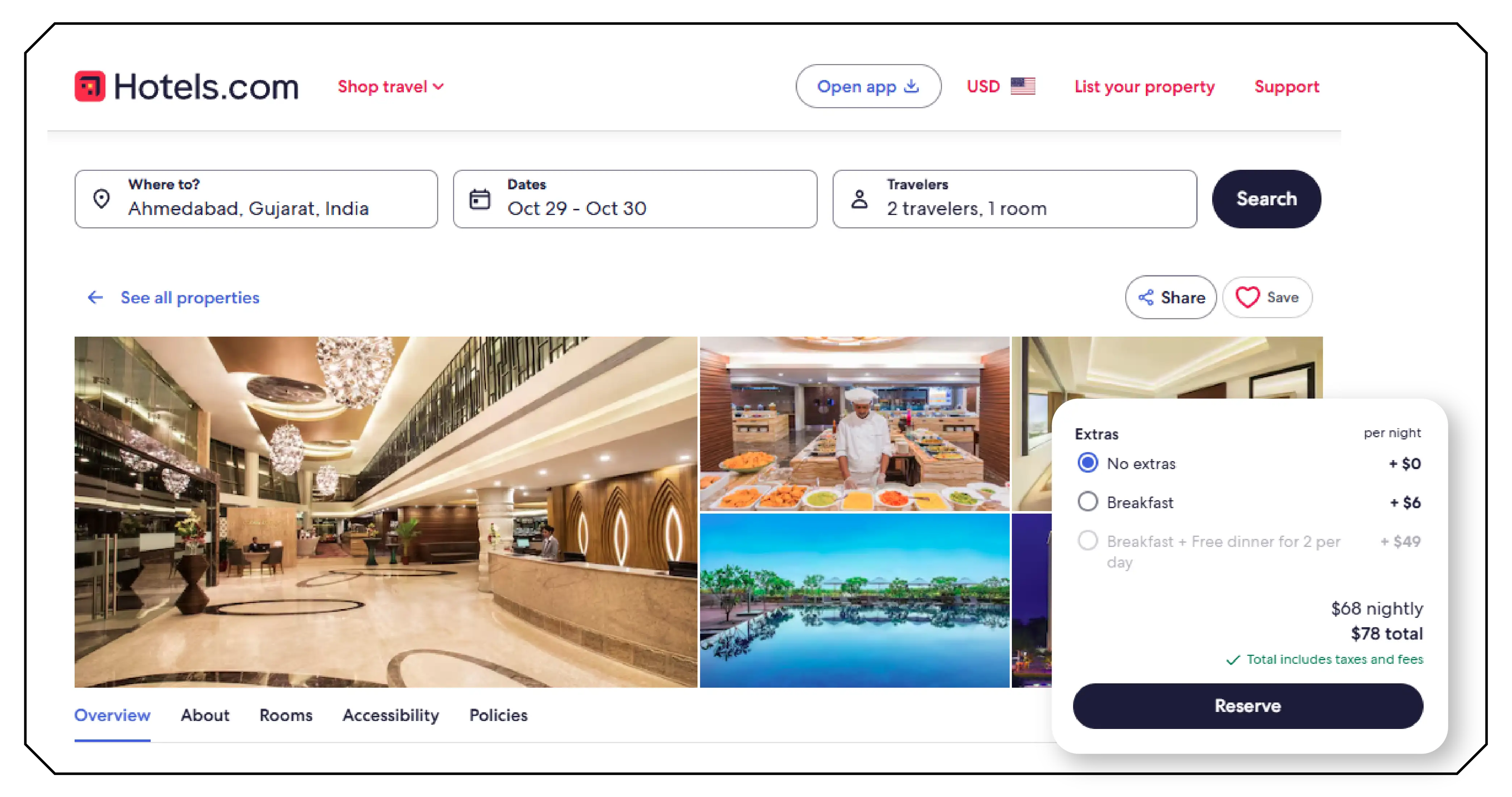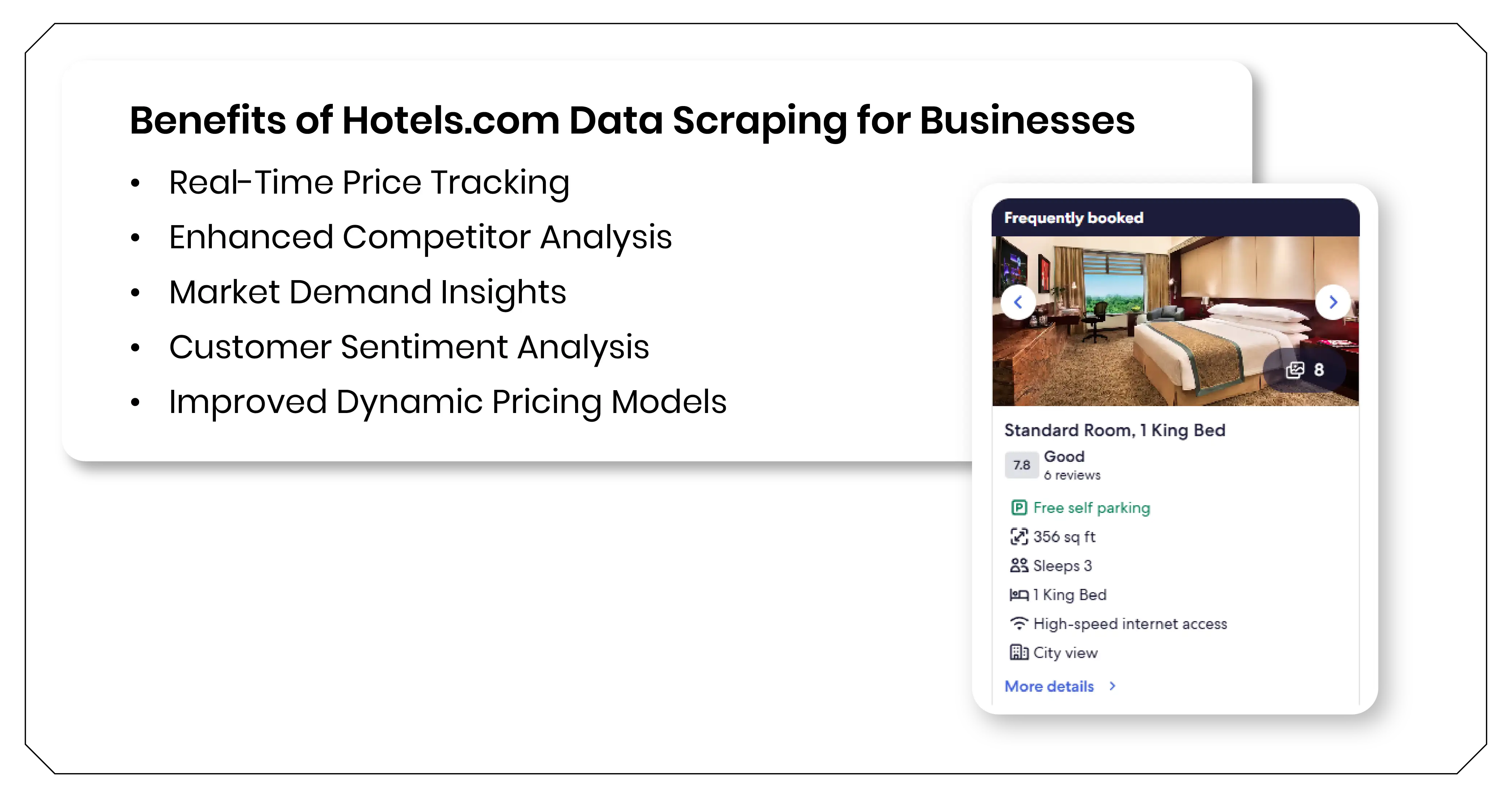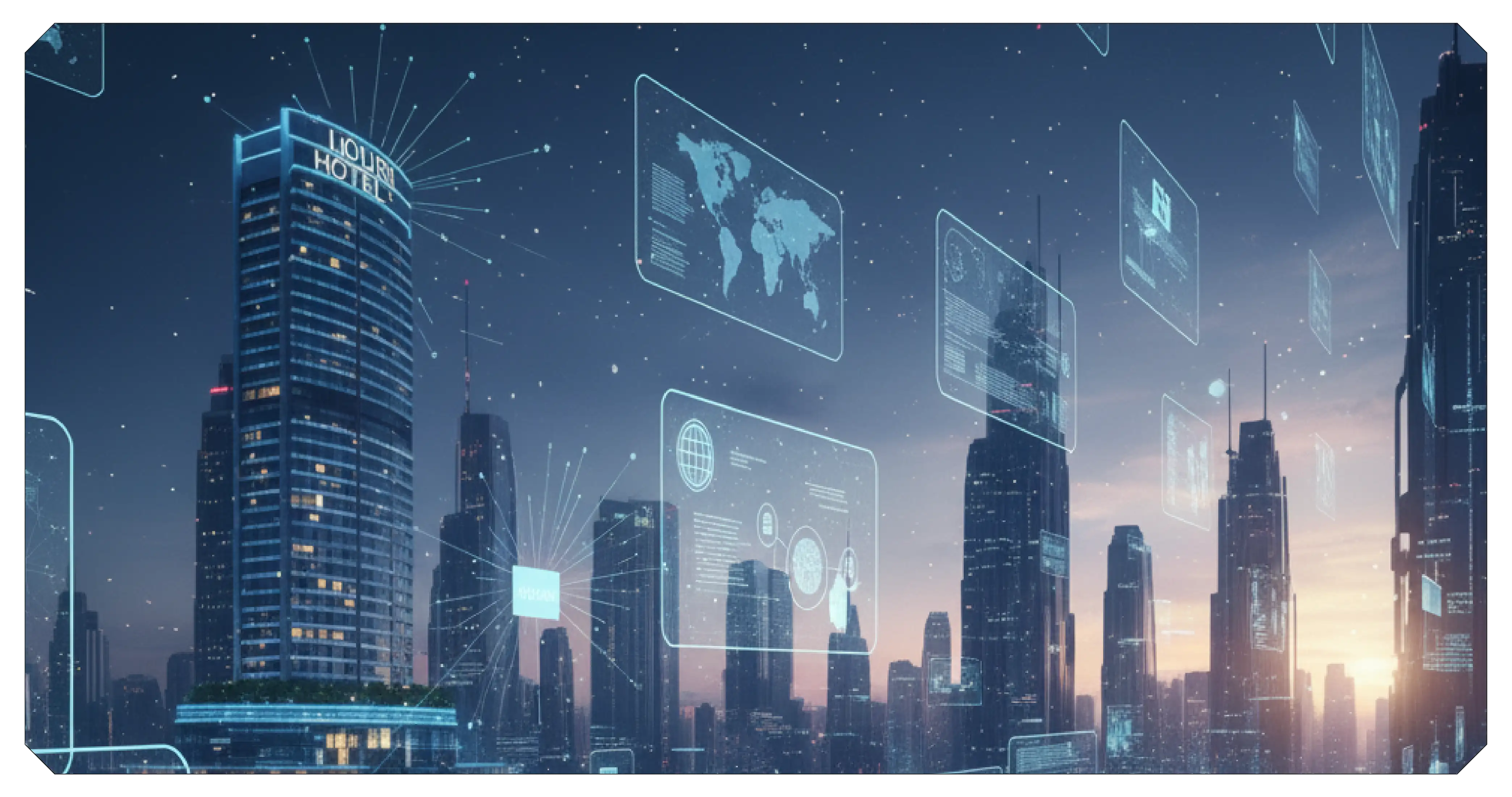What Is Hotels.com Hotel Data Scraping in USA and How Does It Work?

Introduction
In the dynamic travel and hospitality industry, real-time data has become the cornerstone of intelligent decision-making. Businesses ranging from travel aggregators to hospitality analysts rely on vast volumes of data to identify pricing trends, customer behavior, and booking patterns. One of the richest sources of hotel-related information is Hotels.com Hotel Data Scraping in USA, a method that allows the automated extraction of detailed listings, room rates, reviews, and availability from the Hotels.com platform.
With professional Hotel Data Scraping Services , businesses can transform publicly available hotel data into structured datasets for analysis, strategy development, and competitive monitoring. By leveraging these techniques, travel companies, market researchers, and pricing analysts can keep up with rapid shifts in hotel rates, seasonal demand, and guest preferences.
Moreover, businesses looking to Scrape Hotels.com Hotel Data USA for Market Insights gain a deeper understanding of hotel performance, customer satisfaction, and location-based pricing trends. This data is invaluable for dynamic pricing, benchmarking, and identifying emerging opportunities within the U.S. hospitality market.
Why Hotels.com Data Matters in the U.S. Hospitality Ecosystem?

Hotels.com is one of the most influential online hotel booking platforms, featuring millions of properties worldwide, with the United States as one of its largest markets. The platform lists everything from luxury resorts to budget motels and boutique stays. Each listing contains a wealth of structured and unstructured data — such as prices, room types, reviews, ratings, amenities, and nearby attractions — that can be scraped and analyzed for strategic decision-making.
The power of Hotel Data Intelligence lies in how this data can be interpreted and applied. It enables:
- Competitive Benchmarking: Compare hotel rates, room features, and guest satisfaction scores with similar properties.
- Dynamic Pricing Optimization: Identify patterns that influence rate fluctuations across seasons or regions.
- Customer Experience Insights: Analyze guest sentiment and service quality trends.
- Location-Based Market Analysis: Understand which destinations or neighborhoods are most in demand.
- Revenue Forecasting: Predict occupancy rates and demand curves based on historical data.
Hotels.com’s comprehensive and frequently updated listings make it a perfect target for data extraction, helping hospitality stakeholders stay agile in a competitive marketplace.
Scope of Hotels.com Data Scraping in the USA
Scraping data from Hotels.com covers multiple dimensions of hotel analytics, extending from basic listing information to advanced insights into pricing, occupancy, and reviews. Below are the major types of data points that can be extracted through structured scraping frameworks.
1. Hotel Metadata
- Hotel name, location, and star rating
- Contact details and brand affiliations
- Room types, descriptions, and amenities
2. Pricing Data
- Room prices across dates and seasons
- Taxes, surcharges, and cancellation fees
- Discounted offers and promotional codes
3. Availability and Booking Data
- Real-time room availability status
- Occupancy limits and capacity insights
- Minimum stay durations and booking restrictions
4. Review and Rating Information
- Guest reviews, feedback categories, and sentiment analysis
- Average rating scores
- Service-specific ratings (cleanliness, comfort, value, etc.)
5. Location Analytics
- Nearby landmarks, attractions, and business centers
- Map coordinates for geo-based visualization
- Regional demand trends and popularity indicators
For travel technology firms and research institutions, scraping this information offers the advantage of building predictive models, improving customer targeting, and monitoring competitive activity.
How Hotels.com Hotel Data Scraping Works?
Scraping data from Hotels.com involves multiple stages of extraction, cleaning, and analysis. Professional services use ethical, automated methods to gather publicly available information without violating any website’s terms of use. Below is an overview of the typical scraping process.
Step 1: Identifying Data Points
Before scraping begins, businesses define the key information they need — such as pricing data, reviews, or room types. This helps in customizing the scraper to target only relevant pages.
Step 2: Setting Up the Scraper
Developers use specialized tools, APIs, or crawlers to capture structured information from Hotels.com listings. The process often includes rate limits, proxy rotations, and adaptive crawling to ensure accuracy.
Step 3: Extracting and Structuring Data
The extraction tool collects relevant fields such as hotel names, addresses, prices, and availability. Each dataset is then organized into a readable structure like CSV, JSON, or Excel.
Step 4: Cleaning and Normalizing Data
Data cleaning involves removing duplicates, correcting inconsistencies, and normalizing currency or rating scales to ensure usability.
Step 5: Data Integration and Analysis
Finally, the cleaned dataset can be integrated into analytics systems, dashboards, or databases for visualization and strategic insights.
By adopting tools that Scrape USA Hotels.com Hotel Prices and Availability, businesses can maintain up-to-date datasets that reflect real-time market conditions and competitive shifts.
Benefits of Hotels.com Data Scraping for Businesses

The advantages of scraping hotel data extend far beyond simple price monitoring. In today’s data-driven economy, having timely and accurate hotel data can directly influence profitability, strategy, and customer experience.
1. Real-Time Price Tracking
Hotels frequently change their room rates based on demand and seasonality. With tools to Extract Real-Time Hotels.com Hotel Ratings USA, businesses can track these price movements daily or even hourly.
2. Enhanced Competitor Analysis
Travel platforms and hotel chains can compare their listings against competitors, identifying opportunities for better positioning or pricing adjustments.
3. Market Demand Insights
Understanding which cities, seasons, or property types attract the most bookings allows companies to refine their offerings and marketing campaigns.
4. Customer Sentiment Analysis
Through Web Scraping Hotels.com Hotels Data , businesses can analyze thousands of guest reviews to understand strengths, weaknesses, and improvement areas in service delivery.
5. Improved Dynamic Pricing Models
Machine learning models trained on historical and real-time data can predict optimal pricing strategies that maximize occupancy and revenue.
6. Streamlined Distribution Strategy
Hotels can use scraped data to identify underperforming regions, optimize channel distribution, and negotiate better listing visibility on booking platforms.
Understanding the Value of Review Data
Guest feedback is one of the most influential factors affecting booking decisions. A hotel’s rating can make or break its reputation online. Scraping guest reviews from Hotels.com provides insights into what customers truly value and where improvements are needed.
Through Scraping Hotels.com USA Hotel Reviews and Booking Data, businesses can capture:
- Detailed review texts and customer feedback
- Date of review, length of stay, and purpose of travel
- Ratings across service parameters (cleanliness, location, comfort, staff)
- Sentiment polarity — positive, neutral, or negative
- Common themes or frequently mentioned issues
This extracted data can be compiled into a Hotels.com Guest Reviews Dataset , allowing analysts to conduct sentiment analysis and trend monitoring at scale. For example, identifying that “Wi-Fi issues” appear frequently in reviews helps hotel managers address specific service gaps quickly.
Use Cases of Hotels.com Data for Different Industries
1. Travel Aggregators
Travel websites use Hotels.com data to display real-time pricing and availability to their users. This helps them remain competitive and attract customers looking for the best hotel deals.
2. Hotel Chains
Brands use scraping data to monitor competitors in the same region, benchmark performance, and adjust pricing strategies accordingly.
3. Market Research Firms
Analysts use scraped data for tourism demand forecasting, location intelligence, and property performance analytics.
4. Data Science Teams
Researchers and developers build predictive models that forecast hotel occupancy, price elasticity, and review sentiment trends using large-scale datasets.
5. Local Tourism Boards
Destination marketing organizations use aggregated data to understand traveler behavior and optimize tourism campaigns.
These applications highlight the importance of continuous, real-time hotel data collection for effective business planning and forecasting.
Challenges in Scraping Hotels.com Data
While data scraping offers immense potential, it also comes with operational and ethical challenges that must be addressed responsibly.
1. Data Freshness
Hotel prices and availability change frequently; hence, scrapers must be configured for real-time or scheduled updates.
2. Website Structure Changes
Hotels.com may update its site layout or API structure, requiring scraper maintenance and adjustments.
3. Data Duplication
Multiple listings for the same property can cause inaccuracies, demanding efficient data cleaning pipelines.
4. Compliance Considerations
Only publicly accessible data should be collected, ensuring adherence to data protection and fair-use guidelines.
5. Data Volume Management
Extracting data from thousands of listings generates large datasets, which must be processed efficiently using scalable infrastructure.
Professional scraping service providers manage these challenges using proxies, compliance frameworks, and cloud-based infrastructure.
Key Metrics That Can Be Analyzed from Scraped Data
When businesses collect hotel data from Hotels.com, they can analyze a range of metrics for better decision-making:
1. Average Daily Rate (ADR)
Measures the average room revenue per occupied room.
2. Occupancy Rate
Indicates how full a property is on average.
3. Revenue per Available Room (RevPAR)
Combines ADR and occupancy to show profitability.
4. Sentiment Score
Derived from customer reviews, indicating overall satisfaction.
5. Market Share
Comparison of listing performance among competing hotels.
6. Geographical Trends
Identifies high-demand cities and emerging travel destinations.
These metrics are crucial for building competitive intelligence and optimizing hotel management strategies.
Technology Behind Hotel Data Scraping
Modern scraping tools use advanced technologies to handle large-scale data extraction efficiently. Here are some common technologies employed:
- Python Libraries: Tools like Scrapy, BeautifulSoup, and Selenium are used to crawl websites and parse HTML structures.
- Proxies and Captcha Handling: Ensure uninterrupted access to target websites.
- APIs: Where available, APIs allow direct and compliant data access.
- Data Cleaning Pipelines: Automated scripts handle duplicates and ensure data consistency.
- Cloud Storage and Processing: Enables real-time data delivery and easy integration into analytics systems.
These technologies make it possible to extract thousands of hotel listings from Hotels.com without manual intervention, ensuring data accuracy and reliability.
Ethical Considerations and Compliance
Scraping should always adhere to ethical standards and legal boundaries. Responsible scraping involves:
- Accessing only publicly available data.
- Avoiding overloading servers with frequent requests.
- Respecting robots.txt and site-specific policies.
- Ensuring data use complies with relevant regulations like GDPR or CCPA.
By following these principles, data scraping remains a powerful yet ethical method of gathering insights.
Future of Hotel Data Analytics

The next frontier in hotel analytics lies in predictive modeling and AI-driven insights. With access to real-time hotel datasets, companies can:
- Predict booking surges based on events or seasons.
- Personalize travel recommendations for users.
- Identify emerging destinations before they trend.
- Optimize hotel pricing in real time with machine learning.
The combination of scraped data and artificial intelligence creates a powerful ecosystem where decisions are not just reactive but predictive.
How Travel Scrape Can Help You?
- Actionable Market Intelligence: Gain insights into hotel pricing, availability, and amenities across multiple regions to make informed business decisions.
- Dynamic Price Monitoring: Track real-time room rates and seasonal trends to optimize revenue and stay competitive in the hospitality market.
- Enhanced Customer Understanding: Analyze guest reviews and ratings to identify trends, improve services, and enhance the overall guest experience.
- Competitor Analysis Made Easy: Compare your hotel or chain with competitors, discovering strengths, weaknesses, and new market opportunities.
- Flexible and Scalable Solutions: Our scraping services adapt to your business size, providing tailored datasets that integrate smoothly with your analytics platforms.
Conclusion
In today’s competitive travel market, hotel data scraping is more than just a tool—it’s a strategic asset. Access to clean, timely, and structured data from Hotels.com gives businesses an unparalleled advantage in understanding traveler behavior, optimizing pricing, and forecasting demand.
Through Web Scraping Hotels.com USA Hotel Market Price Trends, travel aggregators, hotel chains, and analytics firms can track pricing shifts and competitive positioning effectively. Furthermore, integrating scraping tools that Extract Hotels.com Hotel Listings USA via API ensures continuous data flow for real-time decision-making. Finally, structured datasets such as the Hotels.com Hotel Room Rates Dataset serve as the foundation for advanced analytics, performance benchmarking, and AI-driven business insights.
The U.S. hospitality industry is evolving rapidly — and with comprehensive Hotels.com data scraping, businesses can stay ahead, make smarter decisions, and deliver exceptional experiences to travelers across the country.
Ready to elevate your travel business with cutting-edge data insights? Scrape Aggregated Flight Fares to identify competitive rates and optimize your revenue strategies efficiently. Discover emerging opportunities with tools to Extract Travel Website Data, leveraging comprehensive data to forecast market shifts and enhance your service offerings. Real-Time Travel App Data Scraping Services helps stay ahead of competitors, gaining instant insights into bookings, promotions, and customer behavior across multiple platforms. Get in touch with Travel Scrape today to explore how our end-to-end data solutions can uncover new revenue streams, enhance your offerings, and strengthen your competitive edge in the travel market.

